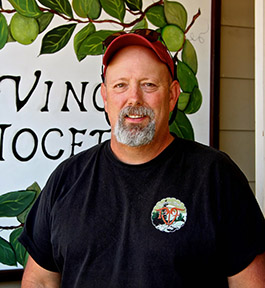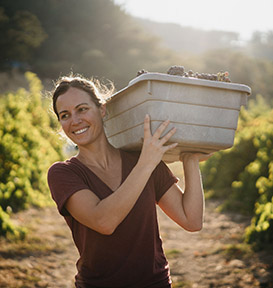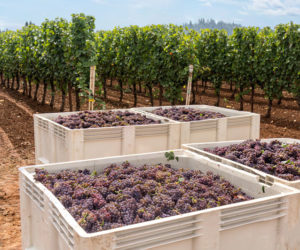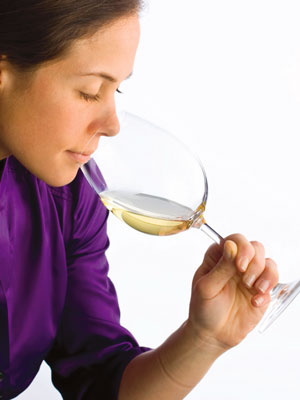Three North American winemakers share their best advice for blending red Italian varieties that are often lesser known and less common in the New World. These grapes bring their own challenges, but can be worth the work.
Rusty Folena: Vino Noceto, Plymouth, California

Sangiovese is the primary red Italian varietal we work with, with 24 acres planted in Amador County, California with two Chianti and three Brunello clones. Two other red Italian grapes we use to a lesser extent are Teraldego and Aglianico.
We are on a decomposed granite, sandy loam, at about 1,200 feet (365 m) elevation, with rows running north to south. We have rolling hills so we end up with quite a few microclimates and the wines tend to show a real earthiness along with some minerality with crisp acid and fruit.
We have the luxury of having up to 20 different Sangiovese lots a year, since we harvest over a period of a couple of months sometimes and use several different fermentation techniques. Even when we are blending just to make varietal Sangiovese wines we have a lot to choose from. And with Teraldego and Aglianico we have a few more blending options with Sangiovese as the base wine. Sometimes we also blend in some white grapes with Sangiovese with the goal of making Italian-style Chianti. Trebbiano calms the acid a bit and Malvasia adds fruit. We also use a little Canaiolo Nero in there.
We can start the blending during harvest, but most of the time blending takes place after the first racking. Then it will evolve over the next 12–18 months, taking small steps as it ages to get to our goal.
Blending is easier given that I have been here for 21 years and have gotten a chance to understand the wines and the vineyards, but we also taste through the cellar often. We will do a couple of sit down tasting blending sessions with Owners Suzy and Jim Gullett, the assistant winemaker, and maybe a couple of folks from our tasting room so they can further their education.
I guess we are pretty stubborn to stick with Sangiovese for so many years. We are lucky here in Amador County the grapes have enough acid and the pH is relatively low. We have hot days of 95+ °F (35 °C) and cool nights in the low 60s °F (~17 °C), typically an afternoon breeze blows in from the Delta which is good for cooling but bad for fires. We keep our crop balanced to what we feel the vine can produce and to get fully ripened. We use several different fermentation techniques: From 1⁄2-ton (450-kg) grape bins to punch down tanks, we will even pull the heads on our puncheons and use them for fermenting, and we do standard pump overs also. I evaluate grapes and decide which way they go year-to-year. Nothing is ever the same. For any home winemakers with the guts to grow Sangiovese, I would say keep an eye on ripeness and over-cropping, which is the biggest concern. If a vine has too much fruit on it, the grapes will not develop the flavors you need.
Lastly, take your time when it comes to Sangiovese and other Italian red grapes. They tend to be a little fickle in the barrel and also on the vine. It’s hard to describe, but there are some days where the grapes and the wine taste great while they are aging and some days you wonder what happened or what was done wrong. So it’s nice to have enough time with these vines and wines to be afforded the time to wait out the ups and downs they go through while they are getting ready to drink. Wine is a living, breathing creature — the process from the vine to the bottle is fascinating.
Martha Stoumen: Martha Stoumen Wines, Sebastopol, California

I work with Nero d’Avola, Negroamaro, and Primitivo, all from the Ukiah area in Mendocino County, California. These parcels are all head-trained and dry farmed. They are grown on low-pH, well-draining, gravelly loam soils, with varying degrees of sandstone and quartz. These growing conditions are definitely a major factor in the grape characteristics.
Nero d’Avola has high acid and medium+ tannin that needs at least ~2 years of aging. If fermented whole cluster, Nero d’Avola in California becomes highly tannic and needs a very long elevage. This is often a stand-alone varietal for me, but I do also make a blend of Nero with Zinfandel to create a fruitier, less tannic red that doesn’t need to be aged as long. This is usually 60% Nero and 40% Zin (these could be swapped if you wanted even less structure).
For blends, I like co-fermenting if the varietals ripen at the same time (which I do with Primitivo and Zinfandel), but if they don’t I usually start blending trials about a month or two after malolactic fermentation (MLF) has naturally completed. I like all of the estery characteristics of primary fermentation and any lactic characteristics from MLF to subside prior to blending. For our cuvées we are over-vintaging, we usually marry the components in the early summer prior to the next harvest. For other wines we are bottling early, or bottle aging, they are blended in the spring after harvest and bottled immediately. It’s also nice to keep the components separate for the first year you work with them, just to get a baseline on flavors.
My Assistant Winemaker, Tim Lyons, and I blend together. We try every lot in the cellar once a month, so already have ideas of what we’d like to try blending before we sit down at the table to do trials. We try to only do three trial variations per cuvée, otherwise you can get stuck down a rabbit hole with the endless possibilities and the half a percent here and there. Honestly, wine changes so much as it ages that there is a bit of a leap of faith in how the blend will play out over the years anyway. We taste the trials right away and make a decision. Occasionally if we are on the fence we re-blend the next day to confirm.
Martin Mackenzie: Petroni Vineyards, Sonoma, California.

The founder of Petroni, Lorenzo Petroni, was infatuated with Brunello and so Sangiovese is the only Italian we produce. These are planted on very steep, hand farmed volcanic rocky slopes in the Moon Mountain District of Sonoma. With these grapes, our priority is to produce the Poggio alla Pietra, a Brunello-style wine from 100% Sangiovese. Lots that do not make the cut are put into a red blend simply called Rosso di Sonoma where they join Bordeaux varietals.
Sangiovese is a pretty sound solo variety. It is enormously influenced by the terrain it grows on — the more rocky and steep the better. Too flat or fertile and the vines get big and the wine dilutes and are more likely to need “help.” My wines are tannic and deserve 10 years in the bottle. We do not release until at least five years from harvest. If I were to blend there would be a choice; if I want to complement the characters with more structure and savory notes then Petit Verdot matches well. To make the wine softer and juicier then Syrah (the natural choice, is that not what the Italians secretly do anyway?) or Zin might help. Cabernets can help focus the fruit but generally Sangiovese can stand alone.
I like to blend sooner rather than later. As soon as I am comfortable with the lot it is blended to Poggio. I have the blends finalized at the rack prior to bottling, so around four to six months prior to bottling. We mature in barrels and puncheons for two years.
I make all the blending decisions on my own. I have been doing this for 12 years and find outside input only creates doubts. I do bench trials prior to racking but generally have a firm idea from having monitored the process from start to finish. I’m a hands-on estate winemaker, we only crush 100 tons or so.
As a home winemaker, my best advice is to get the best Sangiovese from the most arid sites and you will need to blend less. Press early for a softer wine, but do not be afraid to extract for a more serious long-term candidate.







